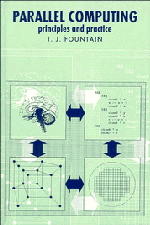Preface
Published online by Cambridge University Press: 29 September 2009
Summary
The study of parallel computing is just about as old as that of computing itself. Indeed, the early machine architects and programmers (neither category would have described themselves in these terms) recognised no such delineations in their work, although the natural human predilection for describing any process as a sequence of operations on a series of variables soon entrenched this philosophy as the basis of all normal systems.
Once this basis had become firmly established, it required a definite effort of will to perceive that alternative approaches might be worthwhile, especially as the proliferation of potential techniques made understanding more difficult. Thus, today, newcomers to the field might be told, according to their informer's inclination, that parallel computing means the use of transputers, or neural networks, or systolic arrays, or any one of a seemingly endless number of possibilities. At this point, students have the alternatives of accepting that a single facet comprises the whole, or attempting their own processes of analysis and evaluation. The potential users of a system are as likely to be set on the wrong path as the right one toward fulfilling their own set of practical aims.
This book is an attempt to set out the general principles of parallel computing in a way which will be useful to student and user alike. The approach I adopt to the subject is top-down – the simplest and most fundamental principles are enunciated first, with each important area being subsequently treated in greater depth.
- Type
- Chapter
- Information
- Parallel ComputingPrinciples and Practice, pp. xi - xiiPublisher: Cambridge University PressPrint publication year: 1994



